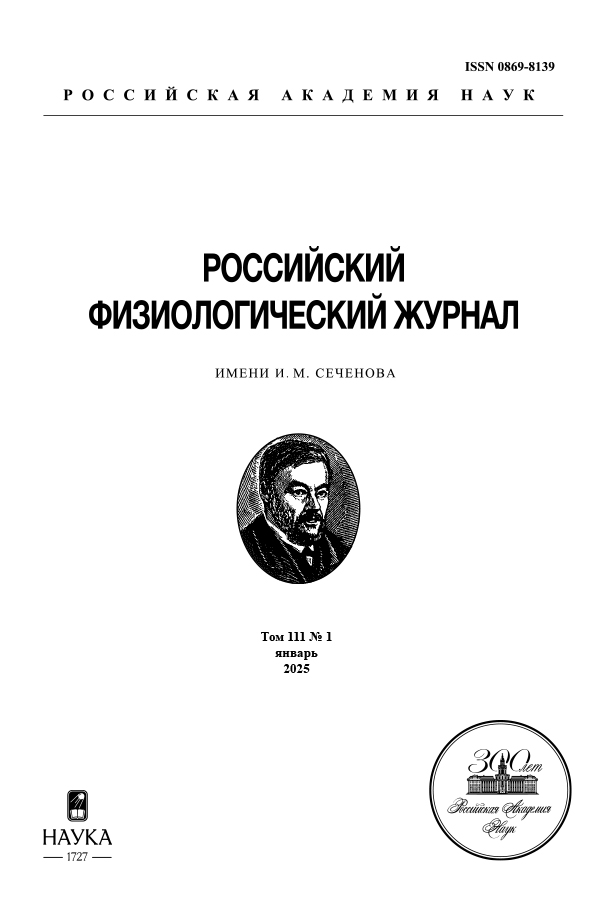Neuroprotective effects of local surface hypothermia during endothelin-1-induced focal ischemia in rat cerebral cortex. II. Morphometric analysis of ischemic lesions
- Authors: Zakirova G.F.1, Chernova К.A.1, Shaymardanova G.F.2, Khazipov R.N.1,3, Zakharov А.V.1,4
-
Affiliations:
- Kazan Federal University
- Kazan Scientific Centre of RAS
- Aix-Marseille University, INMED, IINSERM
- Kazan State Medical University
- Issue: Vol 111, No 1 (2025)
- Pages: 95-106
- Section: EXPERIMENTAL ARTICLES
- URL: https://edgccjournal.org/0869-8139/article/view/682953
- DOI: https://doi.org/10.31857/S0869813925010068
- EDN: https://elibrary.ru/UKGXGI
- ID: 682953
Cite item
Abstract
In the present study, we investigated the neuroprotective effects of local therapeutic hypothermia (LTH) in a model of focal ischemia induced by epipial application of Endothelin-1 to the somatosensory cortex of the rat brain by morphometric analysis of ischemic foci formed 3 hours after Endothelin-1 application. The size of ischemic foci was measured in serial coronal brain slices after staining with 2,3,5-triphenyltetrazolium chloride (TTC). It was found that cooling the cortical surface to 28°C using a subdural Peltier element at 0, 10 and 60 minutes delay after Endothelin-1 application, caused a significant reduction in the size of ischemic focus compared to normothermic conditions. The neuroprotective effects of LTH were inversely correlated with the delay of LTH onset from the time of Endothelin-1 application and were most pronounced with LTH initiated with the shortest (0 and 10 minutes) delay after Endothelin-1 application. The size of the ischemic focus was also found to correlate significantly with the degree of electrical activity suppression analyzed in parallel paper. Taken together, the results of morphological and electrophysiological analysis indicate pronounced neuroprotective effects of surface LTH, particularly significant at minimal LTH latency after ischemic onset, in a model of Endothelin-1-induced focal ischemia in the rat cerebral cortex.
Keywords
Full Text
About the authors
G. F. Zakirova
Kazan Federal University
Email: roustem.khazipov@inserm.fr
Russian Federation, Kazan
К. A. Chernova
Kazan Federal University
Email: roustem.khazipov@inserm.fr
Russian Federation, Kazan
G. F. Shaymardanova
Kazan Scientific Centre of RAS
Email: roustem.khazipov@inserm.fr
Russian Federation, Kazan
R. N. Khazipov
Kazan Federal University; Aix-Marseille University, INMED, IINSERM
Author for correspondence.
Email: roustem.khazipov@inserm.fr
Russian Federation, Kazan; Marseille, France
А. V. Zakharov
Kazan Federal University; Kazan State Medical University
Email: roustem.khazipov@inserm.fr
Russian Federation, Kazan; Kazan
References
- Cheng H, Shi J, Zhang Q, Yin H, Wang L (2006) Epidural cooling for selective brain hypothermia in porcine model. Acta Neurochir (Wien) 148: 559–564. https://doi.org/10.1007/s00701-006-0735-3
- Noguchi Y, Nishio S, Kawauchi M, Asari S, Ohmoto T (2002) A new method of inducing selective brain hypothermia with saline perfusion in the subdural space: effects on transient cerebral ischemia in cats. Acta Med Okayama 56: 279–286. https://doi.org/10.18926/AMO/31690
- Straus D, Prasad V, Munoz L (2011) Selective therapeutic hypothermia: a review of invasive and noninvasive techniques. Arq Neuropsiquiatr 69(6): 981–987. https://doi.org/10.1590/s0004-282x2011000700025. PMID: 22297891
- Hong JM, Choi ES, Park SY (2022) Selective Brain Cooling: A New Horizon of Neuroprotection. Front Neurol 13: 873165. https://doi.org/10.3389/fneur.2022.873165
- Lee H, Ding Y (2020) Temporal limits of therapeutic hypothermia onset in clinical trials for acute ischemic stroke: How early is early enough? Brain Circ 6(3): 139–144. https://doi.org/10.4103/bc.bc_31_20
- Ye J, Shang H, Du H, Cao Y, Hua L, Zhu F, Liu W, Wang Y, Chen S, Qiu Z, Shen H (2022) An optimal animal model of ischemic stroke established by digital subtraction angiography-guided autologous thrombi in cynomolgus monkeys. Front Neurol 13: 864954. https://doi.org/10.3389/fneur.2022.864954
- Sanchez-Bezanilla S, Nilsson M, Walker FR, Ong LK (2019) Can We Use 2,3,5-Triphenyltetrazolium chloride-stained brain slices for other purposes? The application of western blotting. Front Mol Neurosci 30(12): 181. https://doi.org/10.3389/fnmol.2019.00181
- Juzekaeva E, Nasretdinov A, Gainutdinov A, Sintsov M, Mukhtarov M, Khazipov R (2017) Preferential initiation and spread of anoxic depolarization in layer 4 of rat barrel cortex. Front Cell Neurosci 11: 390. https://doi.org/10.3389/fncel.2017.00390
- Vinokurova D, Zakharov A, Chernova K, Burkhanova-Zakirova G, Horst V, Lemale CL, Dreier JP, Khazipov R (2022) Depth-profile of impairments in endothelin-1 – induced focal cortical ischemia. J Cereb Blood Flow Metab 42(10): 1944–1960. https://doi.org/10.1177/0271678X221107422
- Sheroziya M, Timofeev I (2015) Moderate cortical cooling eliminates thalamocortical silent states during slow oscillation. J Neurosci 35: 13006–13019. https://doi.org/10.1523/JNEUROSCI.1359-15.2015
- Burkhanova G, Chernova K, Khazipov R, Sheroziya M (2020) Effects of cortical cooling on activity across layers of the rat barrel cortex. Front Syst Neurosci 14: 52. https://doi.org/10.3389/fnsys.2020.00052
- Van der Worp HB, Sena ES, Donnan GA, Howells DW, Macleod MR (2007) Hypothermia in animal models of acute ischaemic stroke: a systematic review and meta-analysis. Brain 130(Pt 12): 3063–3074. https://doi.org/10.1093/brain/awm083
- He Y, Fujii M, Inoue T, Nomura S, Maruta Y, Oka F, Shirao S, Owada Y, Kida H, Kunitsugu I, Yamakawa T, Tokiwa T, Yamakawa T, Suzuki M (2013) Neuroprotective effects of focal brain cooling on photochemically-induced cerebral infarction in rats: analysis from a neurophysiological perspective. Brain Res 1497: 53–60. https://doi.org/10.1016/j.brainres.2012.11.041
- Al-Ajlan FS, Alkhiri A, Alamri AF, Alghamdi BA, Almaghrabi AA, Alharbi AR, Alansari N, Almilibari AZ, Hussain MS, Audebert HJ, Grotta JC, Shuaib A, Saver JL, Alhazzani A (2024) Golden hour intravenous thrombolysis for acute ischemic stroke: a systematic review and meta-analysis. Ann Neurol 96: 582–590. https://doi.org/10.1002/ana.27007
Supplementary files















